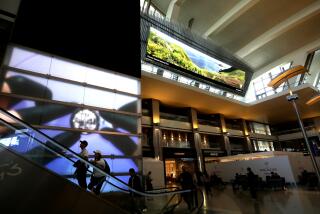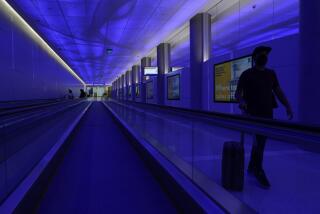Two Airports That Work : London’s Once-Dreaded Heathrow Isn’t Perfect, But Much Improved
LONDON — I spent three hours at London’s Heathrow Airport between planes earlier this year, and I didn’t particularly mind. It wasn’t exactly sitting at a sidewalk cafe on the Champs-Elysees or lying on a beach in Ibiza, but it was, well, not really all that bad.
Now, if you have much experience with international air travel, and thus with the long and dreary hours one inevitably wastes in terminals waiting for flights to leave, you may think this is a bit like saying, “I had a tooth filled at the dentist the other day, and it was sort of fun.” Highly unlikely, in other words.
For the record:
12:00 a.m. Dec. 13, 1992 For the Record
Los Angeles Times Sunday December 13, 1992 Home Edition Travel Part L Page 2 Column 4 Travel Desk 1 inches; 14 words Type of Material: Correction
Dame name--In a Nov. 29 story on London’s Heathrow Airport, Dame Edna Everage’s name was misspelled.
But it’s true. Between approximately 1 and 4 in the afternoon, one Friday last spring, I passed the time quite pleasantly at Heathrow’s Terminal 3. The moment I stepped off the plane (with a heavy piece of hand luggage), I found luggage carts lined up, free for the asking. I wheeled my way along a series of anonymous corridors and then came to a series of broad moving sidewalks which led me swiftly and smoothly to the heart of the terminal. I had an enjoyable light lunch--a freshly-made, not-at-all-soggy chicken-and-green-onion-salad sandwich on quite good walnut bread, a bag of potato chips (sorry, potato crisps ) and fresh-squeezed orange juice--for about $6 at a cheery self-service restaurant called The Granary (at which the chairs and the tables were not attached to one another, incidentally).
After lunch, I browsed through a surprisingly large airport branch of Harrod’s and poked my head into several other shops--not tacky souvenir emporiums, but airport-scale branches of Benetton, Bally and the like. I stepped into a drugstore to buy some aspirin, which cost about what it would have cost in downtown London--none of that ten-tablets-for-three-bucks nonsense that some American airports get away with. I bought copies of The (London) Times and the satirical/muckraking weekly Private Eye at a newsstand and found a quiet cluster of comfortable seats at which to read them.
A bit later, transferring to Terminal 1, from which my connecting flight was to take off, I sampled the new Richard Thompson CDs over earphones at Music Music Music (now called Our Price), bought a couple of paperback spy novels at a well-stocked W.H. Smith bookshop and finally, shortly before boarding my flight, had a small portion of delicious fish and chips at Harry Ramsden’s, a branch of the original Ramsden’s in Guisely, West Yorkshire, which is probably the most famous fish-and-chips shop in England. I almost--but not quite--hated to get on the plane.
Heathrow used to be hell. I started traveling to (and within) Europe by air in the mid-1960s, and--the facilities in certain Eastern European backwaters (and in the larger Italian capitals) aside--Heathrow remained, for nearly two decades, the airport I dreaded most.
I have vivid recollections of boxy, coldly-lit terminal buildings literally reeking with humanity. There were bare stairways and long ramps everywhere; telephones or the bathrooms seemed to be miles away from the gates, or at least to require complicated itineraries to reach. The food (and even the tea) was foul; signs were confusing and passageways were so narrow that when passengers whose flights had been long delayed tried to sleep on the floors, it was all but impossible for other passengers to cross the room.
Ah, how things have changed! The airport is still far from perfect, I hasten to add. Seen from the outside, the place is an architectural disaster, a seemingly random clutter of boring institutional warehouse-like structures, separated by a warren of little roadways lined with fences topped with barbed wire. Inside, portions of the terminals remain boxy, and very long, circuitous walks are sometimes still required. While facilities for transit passengers have undeniably been improved, passengers whose destination is London often complain of long lines clearing immigration controls (not a matter within the airport’s jurisdiction, it might be pointed out) and long waits for baggage.
Still, the changes in Heathrow, through which I travel an average of three or four times a year, have been dramatic for both arriving and transit passengers. It is simply not the same place it was 20 years ago. What was once a nightmare is now, at least intermittently, a utilitarian pleasure.
What happened? Simple: Heathrow went private. In 1987, the British Airport Authority was incorporated as an independent company, free of government sponsorship. It is run like any other major company. Since 1990, in fact, its chief executive has been Sir John Egan, former chairman of Jaguar. Today the BAA also owns the airports at Gatwick, Stansted, Southampton, Glasgow, Edinburgh and Aberdeen. These are, say company officials, the only major privately-owned airports in Europe.
Heathrow is the busiest international airport in the world, having handled more than 33 million international passengers in 1991, compared with 21 million at the Aeroport de Charles de Gaulle in Paris and just over 10 million at LAX. Eighty-five airlines fly out of Heathrow, to over 200 destinations in 72 countries; last year, 709,000 passengers flew between LAX and Heathrow, approximately half in each direction. As many as 150,000 people have passed through the airport in one day; in 1990, a record 1,232 flights took off and landed during a single 24-hour period.
The airport’s origins date from 1944, when the extant Great West Aerodrome was chosen by the British government as the site of a major new military airport. Work began on the project, but the Second World War ended before it could be put to military use, and it was replanned for civilian purposes. The Ministry of Transport and Civil Aviation, which later became the Department of Transport, was given authority over Heathrow, and the first commercial flight to depart from the place was a British South American Airways plane bound for Buenos Aires in 1946. The airport grew rather haphazardly after that, in fits and starts, and in the late 1960s was placed under the jurisdiction of a special management group, the British Airports Authority.
With the construction of new facilities and the remodeling of its terminals, Heathrow had already started to become a more agreeable airport by the early 1980s. But it wasn’t until last year that things really began to change.
I remember my surprise when I first spotted a bright new poster around the airport advertising that Heathrow’s currency exchange facilities would offer travelers the same rates they’d find at “high street” (i.e., downtown) banks. Since airport change bureaus are notorious for their poor rates, I thought this was a pretty nice touch.
Then I started noticing other signs, guaranteeing that retail prices, including drugstore items, also matched high street tariffs.
I even had a decent meal or two at Heathrow--which is more than I can say for recent culinary experiences at Charles de Gaulle, across the English Channel in that great gastronomic capital of Paris. And before long I found myself actually anticipating my arrival at Heathrow (or departure from there) rather than dreading it.
All this was very nice, but I couldn’t help being suspicious. Air travelers passing through a major metropolitan airport--especially an airport attached to a destination as universally popular as London--are a captive audience. Why bother making things nicer for them? Why not just fleece ‘em and feed ‘em beans?
That’s more or less what I asked J. Robert Knowles, the British Airport Authority’s retail director, recently. “To begin with,” he replied, “all our passengers are not a captive audience. About 25% are transfer passengers, using Heathrow as a connection point to somewhere else, so they do have a choice. They could route themselves through another European airport and bypass us altogether.”
Beyond that, he added, it was simply a matter of running the company well, encouraging increased profits while keeping the customer happy: “Passengers react favorably to a fair deal. We don’t want to abuse the fact that we have captive customers--and we plan to expand our retailing quite dramatically over the next two or three years.”
By Dec. 10, a $60-million redevelopment of Terminal 1--which primarily serves other parts of the British Isles and the Republic of Ireland--will be completed, and hundreds of millions of dollars more are earmarked for upgrading the remaining terminals before the end of the century. A whole new terminal is in the works, too, to be designed by renowned architect Richard Rogers (he did the controversial Lloyd’s of London building and co-designed the Centre Pompidou or Beaubourg arts center in Paris). Budgeted at nearly $2 billion, Terminal 5 would double the size of Heathrow, and would alone eventually handle as many as 30 million passengers a year. A final decision on the project isn’t expected until 1997. Meanwhile, on a considerably more modest scale of expansion, in June Australian housewife/superstar Dame Edna Everedge opened a new branch of Harrod’s in Terminal 4, which serves primarily British Airways international flights.
“Since privatization,” Knowles continued, “we’ve identified a number of areas that we were less than happy with, and have systematically gone through them, addressing virtually all airport services and products. For instance, in our duty free/tax free shops, we have a series of price differentials that we insist upon. Certain brands of liquor are required to cost 50% less than high street levels, for instance. With perfumes, you’re guaranteed at least a 21% savings.
“In the case of (food service), we used to have only one food concessionaire per terminal, and frankly the lack of competition allowed some to be not as good as they might.”
Today, each terminal has at least four concessionaires, and between seven and 11 individual restaurants or take-out bars. Besides Harry Ramsden’s, these include everything from Burger King and Dunkin’ Donuts to the Caviar House Seafood and Oyster Bar. The BAA has also commissioned Egon Ronay, the doyen of British restaurant critics, to critique its food outlets and suggest improvements--and to produce a Heathrow food magazine called Egon Ronay Recommends, given away free on open stands throughout the airport. The BAA also interviews about 100,000 passengers a year to gauge their satisfaction level.
London-based travelers are well cared-for, too: The airport, for instance, guarantees a parking space for every ticketed passenger. And any passenger whose journey from a business parking lot to the terminal takes more than 15 minutes is entitled to a free day’s parking or a voucher worth 10 (about $18), which can be spent at any Heathrow shop. There is also special transportation available for drivers with disabilities, and a free jump-start service for cars.
Other nice things about Heathrow: The airport has a population of about 10,000 luggage carts, more, they claim, than any other airport in the world--and their use is absolutely free. And, to get back to those currency exchange facilities, they now offer not only bank rates but a guaranteed buy-back policy: If a passenger changes the equivalent of 300 (about $460) or more, they can sell back up to 30% of the amount changed within one month at the same rate, commission free. (Since this policy was instituted at Heathrow, the Travelex currency exchange stands at some American airports--including LAX and JFK--have instituted their version of the deal: The terms are the same, except the minimum amount changed must be $500.)
Not every one of the airport’s customer service innovations works, however. At one point, I learned from Kate Ellison of the Heathrow Press Office, the airport drew on aspects of its parking shuttle and airline check-in policies, and offered 5 vouchers to anyone kept waiting in a security line for more than 20 minutes. “This turned out not to be a good idea,” she noted, “because people thought we might be stinting on security measures in order not to have to pay the money. We had to discontinue it.”
More to Read
Sign up for The Wild
We’ll help you find the best places to hike, bike and run, as well as the perfect silent spots for meditation and yoga.
You may occasionally receive promotional content from the Los Angeles Times.






